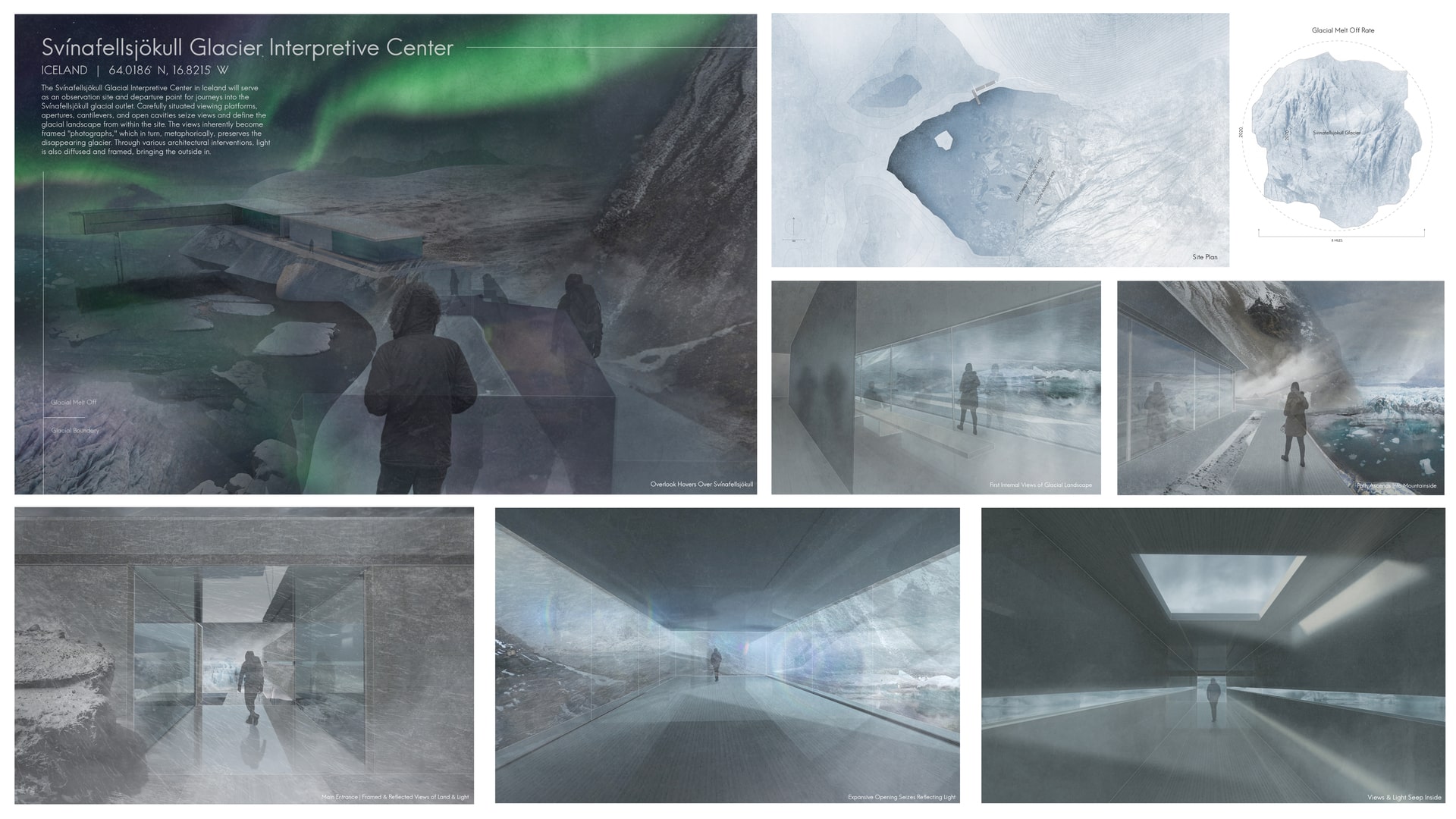Project Description
The Svínafellsjökull Glacial Interpretive Center in Iceland will serve as an observation site and departure point for journeys into the Svínafellsjökull Glacier. Carefully situated viewing platforms, apertures, cantilevers, and open cavities seize views and define the glacial landscape from within the site. The views inherently become framed “photographs,” which in turn, metaphorically, preserves the disappearing glacier. Through various architectural interventions, light is also diffused and framed, bringing the outside in. Location: The site location for the Svínafellsjökull Glacial Interpretive Center is on county road Vinasfellsjokulsvegur, off the scenic highway Route 1, in the southeast quadrant of Iceland. Route 1 is also known as Ring Road, a popular scenic highway that continuously encircles the entirety of the country. Svínafellsjökull Glacier is an outlet in the vast Vatnajokull National Park. Vatnajokull began formation approximately 2,500 years ago and is the largest, most voluminous ice cap in Iceland, covering 8% of the country. Navigation: The visitor will park off Vinasfellsjokulsvegur county road, or hike from within the National Park. As the visitor approaches the site, they are greeted with a ramp that slightly descends into the site. As the visitor walks down the ramp, they encounter a reflective entry way into the site. The entryway is translucent but highly reflective. The visitor can choose to walk through the entryway and onto the path that ascends the mountainside, or to the left or right viewing platforms. As the visitor walks through the left entrance, they are greeted with the first internal views of the glacial landscape. The view is expansive and quiet. The semi-opaque divider allows visitors to walk past the first viewing area without disturbing other visitors. The path continues to an additional viewing space, which is separated from the first by a brief moment outside. The views inside feel endlessly expansive, as the glazing wraps around the end of the building for a 270-degree view. The light reflected off the glacier, mountains, and snow fall on the highly reflective interior surface. The building to the right of the main path is characterized by two long, narrow apertures. The opening to the horizon frames a sliver of the glacial landscape. The opening to the top frames the sky. The size and shape of the apertures help to emphasize the span of the landscape and is reminiscent of a crevasse within the glacier. Light creeps in through the openings and reflects off the interior surface. At the end of the building, the visitor can step outside for a scenic, cantilevered view of the glacier. The exterior path which ascends into the mountainside is characterized by a glass rail. The three observation decks on the path extend over the glacier and into the mountain, allowing for expansive and unique views of the glacial landscape. From this perspective, the visitor can watch the glacier change as the day passes. The melt off from the glacier freezes, thaws, recedes, and glows in the night. During winter evenings, when the aurora is visible, the lights from above reflect and pulse off the glacier, creating a kaleidoscope of light. This unique experience can only be seen while on or above the glacier. The center is open year-round, from dawn to dusk. Visitors can choose to stay in the site or continue into the landscape. Future: According to scientific data, 50% of Icelandic glaciers will disappear within 50 years as a result of climate change. To the general public, glaciers define climate change because their change can be readily observed. If no action is taken regarding climate change, Svínafellsjökull glacial outlet will melt. The interpretive site will then inherently become a memorial site. Visitors will still be able to enjoy views of the mountainous landscape, but the views will be drastically different. Melt-off from the glacier will seep into the site, creating lagoons of transparency and reflection from the dead glacier. The site will be a place of remembrance, a place where people can speak of the lost glacial landscape. It will serve as a reminder of what was lost as a result of inaction.
